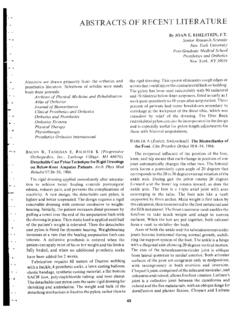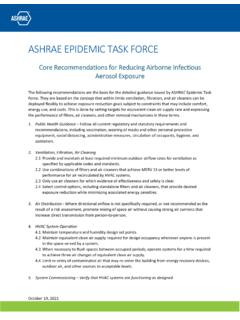Transcription of Conditioning Exercises - Veterans Affairs
1 PART TWOCONDITIONINGEXERCISESNEWSDAY/J. CONRAD WILLIAMS, physical Conditioning routines included inthis book offer possibilities for individuals withlower limb amputation. We begin with calisthenicsand stretches to improve flexibility and range ofmotion, followed by Exercises to develop strengthand muscular endurance in specific muscle groupsfor the arms, shoulders, legs, abdomen, chest, Conditioning Exercises are performed withequipment such as Nautilus, available in most healthclubs. An individual with a lower limb amputationcan usually work the same muscle groups on thesame equipment as can a nondisabled person, butnot always in the same adaptations or modifications that willhelp to make these Exercises safe and effective arenoted in the corresponding descriptions.
2 In manycases, the prosthesis alone provides the necessarysupport for the movements required. Exercises thatwill help strengthen the muscles of the residual limbare also indicated in the descriptions. Many of theexercises in Part Two are performed while theparticipant is seated; this allows the participant toconcentrate on the Exercises and weights withouthaving to worry about maintaining balance for some of the Exercises depend onthe level of amputation. Range of motion andbalance may not be the same for a person with anAK amputation as they are for someone with a BKamputation.
3 Besides level of amputation, othervariables include the surgical history, previous train-ing, and type of prosthesis used. The prosthetist,therapist, and exercise instructor can help identifythe best opportunities for exercise based on Exercises illustrated in this book are per-formed by athletes who train on a regular basis. Allare in excellent physical condition and demonstrateexercises that require a range of skill and should not attempt to perform any of theexercises without first consulting a with back injury should avoid liftingheavy weights in their exercise programs.
4 To developstrength and endurance, they should do morerepetitions with light weights rather than increasingthe exercise has the potential to cause injury tothe back, whether or not one has had previous backinjury. In particular, this would include sit-ups andother Exercises involving hyperextension of the back,as noted in Chapter 10, Abdominals, Leg exercisesrequiring special caution, as noted in their descrip-tions, are squats and dead lift. Exercises that makethe lower back vulnerable to injury are noted inChapter 12, Back is important that persons entering an aerobicexercise program obtain medical clearance prior tooutlining the exercise regime.
5 This precaution isrepeatedly stressed throughout this text. Individuals2324 RRDS Clinical Guide. Physical Fitness: A Guide for Individuals with Lower Limb Losswho have hypertension, for example, are particu-larly at risk in weight training as well as aerobicprograms. Coronary artery insufficiency is anotherexample of a risk factor in undertaking an aerobicexercise program. These risks apply for thenonamputee as well as the amputee. Medical clear-ance at all ages is absolutely THE INTENSITY OF AEROBICEXERCISEIn order for exercise to promote optimumaerobic benefit, it must cause the heart to work atan accelerated rate and in a steady state for a periodof time.
6 Monitoring the heart rate during exercise isthe best way to determine whether the routine isproviding the desired aerobic benefits while ensuringthat the heart is not being overworked. It is done byestablishing a target heart rate and monitoring thebeats per minute immediately after the conditioningexercise routine is completed. The goal is to main-tain the target heart rate throughout the exerciseperiod (warm-up and cool-down are not part of thisperiod).Establishing a Target Heart Rate RangeA target heart rate range for exercise can bepredicted as follows: 1) a person's age in years issubtracted from 220 to give the maximum predictedheart rate (beats per minute); 2) the range isdetermined by figuring the percentage of the maxi-mum rate that the person must work during exercisein order to achieve his/her target goal (70 to 85percent is the range which is considered to be themost effective for receiving adequate aerobic bene-fits).
7 For example, a 35-year-old person will have amaximum predicted heart rate of 185 (220 minus35). If this person begins an exercise regimen with agoal of maintaining a 78 percent target heart rate,his/her target will be 144 heartbeats per minute(0 .78 times 185).Exercise at the targeted rate should last from 15to 30 minutes. During this time the heart rate ismonitored. Immediately after the routine is com-pleted, the pulse should be taken to determine theheart rate. Most people take a 10-second, ratherthan a full minute, pulse count.
8 The 10-secondcount is then multiplied by 6. Any irregularity inheart rate, including rapid variations, calls forSAMPLE CIRCUIT TRAININGSIT UPSBENCH PRESSLATERAL PULL DOWNLEG PRESSSIT UPSMILITARY PRESSPULL UPSINCLINE PRESS25 Conditioning Exercises : Introductiondiscontinuing the exercise immediately and consult-ing a Target Heart Rate Range for Moderate ExerciseCertain individuals may not be able to exerciseas strenuously as others. A 60 to 65 percent ofmaximum heart rate is a safe and still effectivetarget range, especially for an older person.
9 An evenlower rate may be necessary for some individuals;therefore, when the intensity is lower, the exerciseperiod should be extended from 30 to 50 of overuse include fatigue, poorsleeping patterns, and discomfort for extendedperiods of time following exercise. If it is difficult toreach a heart rate of at least 60 percent ofmaximum, a lower rate will give adequate aerobicbenefits if the number of repetitions of each exerciseis OF MUSCULAR CONDITIONINGTO HEALTHM uscular Conditioning is vital to overall body movements rely on the relationshipbetween the muscular and skeletal systems.
10 Weighttraining can reduce the resting heart rate and iseffective for relieving stress. With the proper diet,body fat can also be reduced while muscle mass isbeing properly with weights is the mosteffective way to build strength and muscular endur-ance. Heavy weight resistance with a low number ofrepetitions builds strength, while light weight resis-tance with a high number of repetitions BenefitsWeight training is essentially anaerobic it does not develop the cardiovascular systemas well as running, swimming, or bicycling, weight-resistant exercise will develop strength and endur-ance in the muscles of the legs and upper body sothat those muscles do not tire before the cardiovas-cular system can be the intensity level of weight training is kepthigh.















